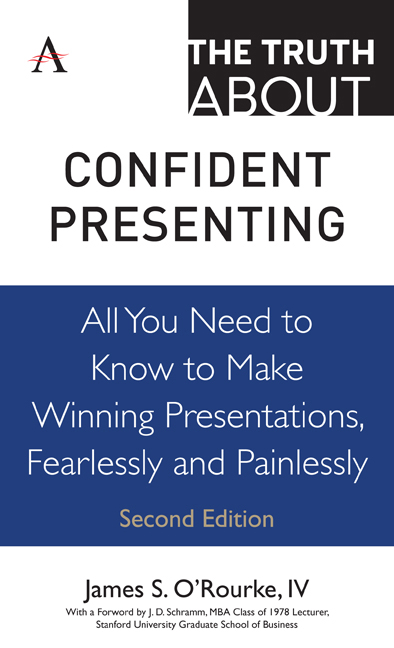 The Truth about Confident Presenting
The Truth about Confident Presenting Book contents
- Frontmatter
- Contents
- Foreword
- Introduction
- Part I Some Initial Truths
- Part II The Truth About Getting Ready to Speak
- Part III The Truth About What Makes People Listen
- Part IV The Truth About Developing Support for Your Presentation
- Part V The Truth About Getting Up to Speak
- Part VI The Truth About Managing Anxiety
- Part VII The Truth About Nonverbal Communication
- Part VIII The Truth About Visual Aids
- Truth 41 Visual aids can help your audience understand your message
- Truth 42 Understand visual images before you use them
- Truth 43 Choose the right visual
- Truth 44 Use PowerPoint effectively
- Truth 45 Consider speaking without visuals
- Part IX The Truth About Handling an Audience
- Part X The Truth About What Makes a Presentation Work
- References
- Acknowledgments
- About the Author
Truth 41 - Visual aids can help your audience understand your message
from Part VIII - The Truth About Visual Aids
- Frontmatter
- Contents
- Foreword
- Introduction
- Part I Some Initial Truths
- Part II The Truth About Getting Ready to Speak
- Part III The Truth About What Makes People Listen
- Part IV The Truth About Developing Support for Your Presentation
- Part V The Truth About Getting Up to Speak
- Part VI The Truth About Managing Anxiety
- Part VII The Truth About Nonverbal Communication
- Part VIII The Truth About Visual Aids
- Truth 41 Visual aids can help your audience understand your message
- Truth 42 Understand visual images before you use them
- Truth 43 Choose the right visual
- Truth 44 Use PowerPoint effectively
- Truth 45 Consider speaking without visuals
- Part IX The Truth About Handling an Audience
- Part X The Truth About What Makes a Presentation Work
- References
- Acknowledgments
- About the Author
Summary
Behavioral scientists have known for many years that visual images can have a powerful effect on the process of learning. In some instances, the use of pictures may reach people who simply don't listen well to the spoken word, or who may not understand what the words mean.
Professor G. M. Ingersoll discovered in his studies at Penn State University that some people pay more attention to what they see than what they hear. That means, of course, that some people remember more of what they see, while others remember more of what they hear. The reasons for this phenomenon are complex and may have more to do with the way our brains are organized than our preferences for pictures or sound. In his experiments, Professor Ingersoll found that some people more quickly and readily recall information and concepts that had a visual component. Others were more tuned in to the spoken word.
The implication for public speakers seems clear: while visual information may serve to explain or reinforce spoken information, it may also reach a significant number of audience members who do not readily attend to, understand or remember the spoken word. Other behavioral scientists have found that a word plus a related picture combination is superior to either words or pictures alone.
So, what does this mean for you? Several things. First, research clearly shows that visual support will help to explain, reinforce and clarify the spoken word during a presentation. That means, if you can't say it easily, you can show it to your audience. The research clearly implies something important for all speakers. If some people pay more attention to what they see and others to what they hear, don't leave anyone out. Say it to them, show it to them and tell them where they can find more information.
Visual information tends to work best when you have new data for your audience, or when the information you hope to convey is complex or technical in nature. Visuals are also helpful if your message is 41 coming to them in a new context. Numbers, quick facts, quotes and lists frequently benefit from some form of visual display. And, unquestionably, showing your audience comparisons in visual form is easier than telling them and helps them to understand how one item compares to another over time or in cumulative effect.
- Type
- Chapter
- Information
- The Truth about Confident PresentingAll You Need To Know To Make Winning Presentations, Fearlessly And Painlessly, pp. 163 - 166Publisher: Anthem PressPrint publication year: 2019


